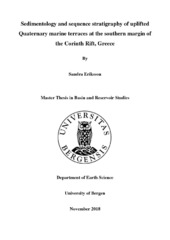Sedimentology and sequence stratigraphy of uplifted Quaternary marine terraces at the southern margin of the Corinth Rift, Greece
Master thesis
Permanent lenke
https://hdl.handle.net/1956/18941Utgivelsesdato
2018-11Metadata
Vis full innførselSamlinger
- Department of Earth Science [1033]
Sammendrag
The purpose of this study is to identify the sedimentology and stratigraphic sequence of the uplifted, Quaternary marine terraces in the Corinth Rift, Greece. The area of study is located south of Xylokastro and, as opposed to previous work, this project focused on small-scale mapping and logging, rather than determining the large-scale morphology of the area, resulting in a more detailed map of the area in terms of deposits and their extent. A comparison is then made to conclude whether the method used to map the area still holds strong in comparison to detailed fieldwork. There is a lot of lateral variation between terraces, sometimes they are depositional and in other areas they may be dominantly erosional, and a total of 13 different terrace levels were mapped, some with sub-levels. It was found that marine terraces remain highly laterally continuous despite large distances unlike their fluvial counterparts. The deposits are the stratigraphically youngest, marine terraces, which were deposited between 0.7-0.45 Ma to present. Six marine terrace facies were observed in the area, of which they are all consisting of beachface facies, with some shoreface deposits present. Cross-sections were made in order to create trajectories, which were then used when considering sea-level variations and a general vertical succession. With the detail of the study, it has been observed that within terrace levels there are small-scale transgressions present as well as across terrace-levels, suggesting the need to include changes by transgression into the previous interpretation of terraces, which was generated by uplift alone. A correlation between the elevation of the terraces (given by age constraints) and a glacio-eustatic sea-level curve suggest an uplift rate of 1.3 mm/year is more likely than 1.6 mm/year. However, neither provided a perfect fit, therefore the best fit may more likely lie in-between or alternatively the use of a non-linear uplift rate.
